Tree limb removal often becomes necessary after a branch falls unexpectedly—but by identifying the warning signs early, you can prevent major property damage and injury. Whether you’re maintaining your own trees or managing a property, knowing what to look for can protect you from dangerous surprises.
Why Spotting Weak Limbs is Crucial
Preventing Property Damage and Personal Injury
Weak limbs can fall at any time—during storms, in heavy winds, or even on a calm day. A sudden break can crush a car, damage a roof, or worse, harm someone nearby. Early detection of unstable branches is your first line of defense.
Protecting Overall Tree Health
A decaying or damaged limb doesn’t just pose a falling risk—it also puts stress on the rest of the tree. Over time, unresolved damage can spread, making the entire tree vulnerable to failure or disease.
Ignoring one failing branch can invite pests or diseases that spread to nearby limbs or even adjacent trees, turning a manageable issue into widespread canopy decline or loss.
The Importance of Proactive Observation
Many homeowners only notice limb problems after a fall has occurred. But with regular observation and awareness, you can catch signs of weakness early and take action—avoiding costly repairs and emergency tree limb removal.
Visual Signs of Weakness
Dead or Dying Branches
A branch without leaves during growing season is a red flag. These limbs often feel dry, brittle, or hollow. When tapped, they may produce a dull, hollow sound—indicating they’re already dead and should be removed.
Peeling Bark and Lack of Foliage
Bark peeling away from branches and sparse or absent foliage are key indicators of stress or death. These branches are more likely to fail without warning and require prompt tree branch removal.
Fungus or Mold Growth
Fungal growth—like mushrooms or mold—on a limb’s surface signals rot. Once fungus is present, the wood beneath is typically soft or compromised, making it susceptible to sudden breakage.
Cracks in Limbs or Trunk
Visible splits or cracks in a branch or the trunk, whether vertical or spiral, weaken a tree’s structure. These cracks may form at stress points and are often precursors to limb drop or full collapse.
Cracks at Branch Unions
Pay close attention to the branch collar—the area where limbs meet the trunk. Cracks at these junctions indicate separation risk, which can lead to broken tree branch removal after failure occurs.
Decay or Cavities
Soft, crumbling wood or holes within a branch signal internal decay. Sometimes these cavities aren’t visible until limbs snap—but if you see hollowed or spongy areas, removal is necessary.
Shelf Fungi or Conks
Flat, shelf-like fungi growing from the trunk or large branches (called conks) indicate significant decay. Their presence usually means the interior structure of the wood is compromised.
Weak Branch Unions
Branches that form a tight V-shape instead of a wide U-shape where they connect to the trunk are structurally weaker. These V-shaped joints are more likely to split under wind, snow, or the branch’s own weight.
Included Bark
Included bark forms when two branches grow closely together and trap bark between them instead of forming strong connective tissue. This inward-growing bark causes instability and often leads to cracks and failure.
Excessive Lean or Imbalance
Limbs—or entire trees—that lean suddenly or severely may indicate root instability or structural failure. Imbalance can cause trees to become top-heavy, increasing the risk of limb loss, especially on the weighted side.
Other Indicators of Danger
Hanging or “Hung Up” Branches
After a storm, branches may become detached but remain suspended in the canopy. These “hung up” limbs are especially hazardous and often fall unexpectedly. Never try to remove them yourself—call for emergency tree limb removal.
Pest Infestation
These pests often target stressed or dying wood, weakening limbs that would otherwise remain stable in healthy, thriving trees. Boreholes, sawdust piles, or excessive insect activity may signal internal damage. Pests like carpenter ants, termites, and beetles can hollow out branches, weakening them from the inside out.
Root Damage
A tree’s stability starts underground. Signs like heaving soil, exposed roots, or nearby excavation suggest root damage. When roots are harmed, the tree’s upper structure—including its limbs—can become unstable.
Proximity to Power Lines or Structures
Branches that hang over roofs, driveways, or grow near power lines pose immediate risks. Even healthy limbs can cause problems in the wrong location, and should be assessed by professionals.
What to Do If You Spot a Dangerous Limb
Do NOT Attempt to Remove It Yourself
Large or high limbs can be extremely dangerous to cut without training. DIY attempts can lead to personal injury, damage to property, or even greater tree harm. Leave it to a certified arborist with proper tools and insurance.
Keep People, Pets, and Vehicles Away
If you suspect a limb might fall, restrict access to the area immediately. Place barriers or visual markers and relocate vehicles and pets until a professional can assess the situation.
Contact a Certified Arborist Immediately
Tree professionals like Lopez Tree Services have the experience to safely handle tree limb removal, no matter the complexity. They’ll inspect the tree, determine structural risk, and handle removal in a safe, efficient manner. For urgent cases, emergency tree limb removal is available to mitigate immediate hazards.
Your Vigilance Saves Lives and Property
Falling branches aren’t just inconvenient—they’re dangerous. From minor property damage to severe personal injury, and even costly legal issues, the consequences of ignoring warning signs can be devastating. But most limb failures are preventable with proper awareness and action.
By learning what to look for—cracks, fungus, imbalance, decay—you’re taking the first step toward safer trees. Don’t wait for an emergency. Schedule regular inspections, stay observant, and take action when signs appear.
For expert tree limb removal, inspections, and emergency response, contact Lopez Tree Services today. We’ll help you spot risks early and keep your property—and everyone on it—safe year-round.




